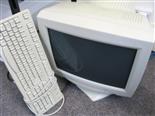
Computer Recycling:
Is the recycling or re-use of computers or other electronics. It includes both finding another use for the materials (such as donation to charity) and having them dismantled in a manner that allows safe extraction of the constituent materials for re-use In other products.
Reasons For Recycling:
Obsolete computers and other electronics are a valuable source of secondary raw materials if treated properly. If treated improperly they are a source of toxins and carcinogens.
Rapid technology change, low initial cost, and even planned obsolescence have resulted in a fast-growing surplus of computer or other electronic components around the globe.
Many materials used in the construction of computer hardware can be recovered in the recycling process for use in future production.
Reuse of tin, silicon, iron, aluminium and a variety of plastics all present in bulk in computers or other electronics, can reduce the costs of constructing new systems.
In addition, components frequently contain copper, gold, and other materials valuable enough to reclaim in their own right.
How They Are Recycled?
Step 1:
At the sorting facility the computers are first sorted in to sections for re-use or recycling.
Step 2:
Computers that fall in to the re-use category are refurbished with parts and then sold at discount prices.
Step 3:
Computers that are sent for recycling are first dismantled and any useable parts are salvaged to be refurbish the working computers. Any broken parts or pieces are separated in to sections such as motherboards, ram, power supplies etc.
Step 4:
The sections of parts are then sold to specialist recyclers who can extract the valuable materials. Any material that cannot be sold, re-used or recycled is incinerated to generate energy from the product.
Cathode Ray Tubes:
Used in old computer monitors they pose a threat to human health and are classed as a hazardous material.
The phosphor-based coating used to provide the luminescence contains heavy metals and other toxins, while the glass itself is loaded with lead and barium.
This means that when CRT’S come to there end of life they, need to be recycled and disposed of effectively to avoid pollution.
Recycling a specific design of CRT is relatively straightforward, but finding a process that will handle very large quantities of CRTs of varying age and specification is not so easy. As a result over 30,000 tonnes a year currently go into UK landfill.
In The UK:
British Industry throws out over 1,000,000 computers every year because they will not run the very latest software, and it is cheaper for companies to buy new computers than to upgrade old ones.
The total annual waste arising from computers, workstations and systems in the UK has been estimated to be in excess of 340,000 tonnes